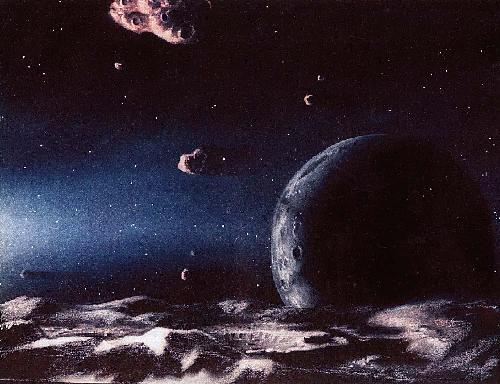 |
 |
|
| Comet | Jewitt | Kuiper |
|---|
| P/2010 A2: Timeline |
|---|
2009 February/March
The precursor body to P/2010 A2 disrupted, unseen in the daytime sky (from Earth). Debris began to expand away from the nucleus.
A morphologically peculiar, diffuse object was detected by software running on the US Air Force LINEAR telescope. The object was reported to the Minor Planet Center in Cambridge, MA.
Minor Planet Center (IAU Circ., 9105) announces P/2010 A2 as a short-period comet. Most such objects are recent escapees from the Kuiper belt. However, the published orbit is obviously that of an asteroid, making this the 5th known Main Belt Comet.
I ask Jim Annis to take a few images for me from the WIYN telescope on Kitt Peak, that night. Images from the WIYN reveal a peculiar morphology, unlike anything I've seen in 3 decades of comet observing. I guess that this is a collision cloud and that it is recent, maybe only a week or two old.
Our WIYN results and impact hypothesis are published in IAU Circular (IAU Circ., 9109).
With Harold Weaver, Max Mutchler and Michal Drahus, write a proposal to the Director of HST requesting discretionary observing time. Argued that the time was urgent since the event "just happened" and A2 was expected to rapidly dissipate.
First HST image secured, showing the "X" structure and much fine detail.
After 2nd visit to A2 on Jan 29, write a second proposal to the Director requesting time to monitor the evolution of the object. The evolution in A2 between images appears very slow, suggesting that the causal event occurred not days or weeks previously, but many months in the past.
Last image in the Hubble sequence taken. A2 moved into the Sun exclusion zone as seen from HST. By this time we had measured the size of the primary nucleus, identified transient sub-nuclei, discovered the "X" and dust sources in the "X", established that the X extends perpendicular to the orbit plane, found that the object originated in early 2009 and that it must therefore have evaded detection for about 10 months before LINEAR found it, observed that the tail thickness *decreased* with time (indicating collapse back to the orbit plane), and measured very low internal speeds (20 cm/s c.f. orbital speeds of 20 km/s).
David Jewitt
Hubble Image Sequence
 |
 |
|
| Comet | Jewitt | Kuiper |
|---|